Management Accounting: Budgeting Process and Behavioral Aspects Report
VerifiedAdded on 2021/06/15
|10
|2291
|39
Report
AI Summary
This report provides a comprehensive analysis of the budgeting process in management accounting, emphasizing its critical roles and behavioral aspects within organizations. It explores the scope and nature of budgeting, detailing its importance and impact on workers. The report outlines the budgeting sequence, including steps like preparing worksheets, discussing plans, and obtaining approvals. It further examines the fundamental elements of an effective budgeting process, such as effective communication, clearly defined goals, management involvement, coordination, and actual performance reporting. Various budgeting methods, including incremental, zero-based, and top-down budgeting, are also discussed. Moreover, the report investigates the behavioral aspects of budgeting, including participation levels, the importance of clear communication, and the impact of performance feedback. The conclusion highlights the significance of budgeting and variance analysis for cost control and performance assessment. The report is supported by several academic references.
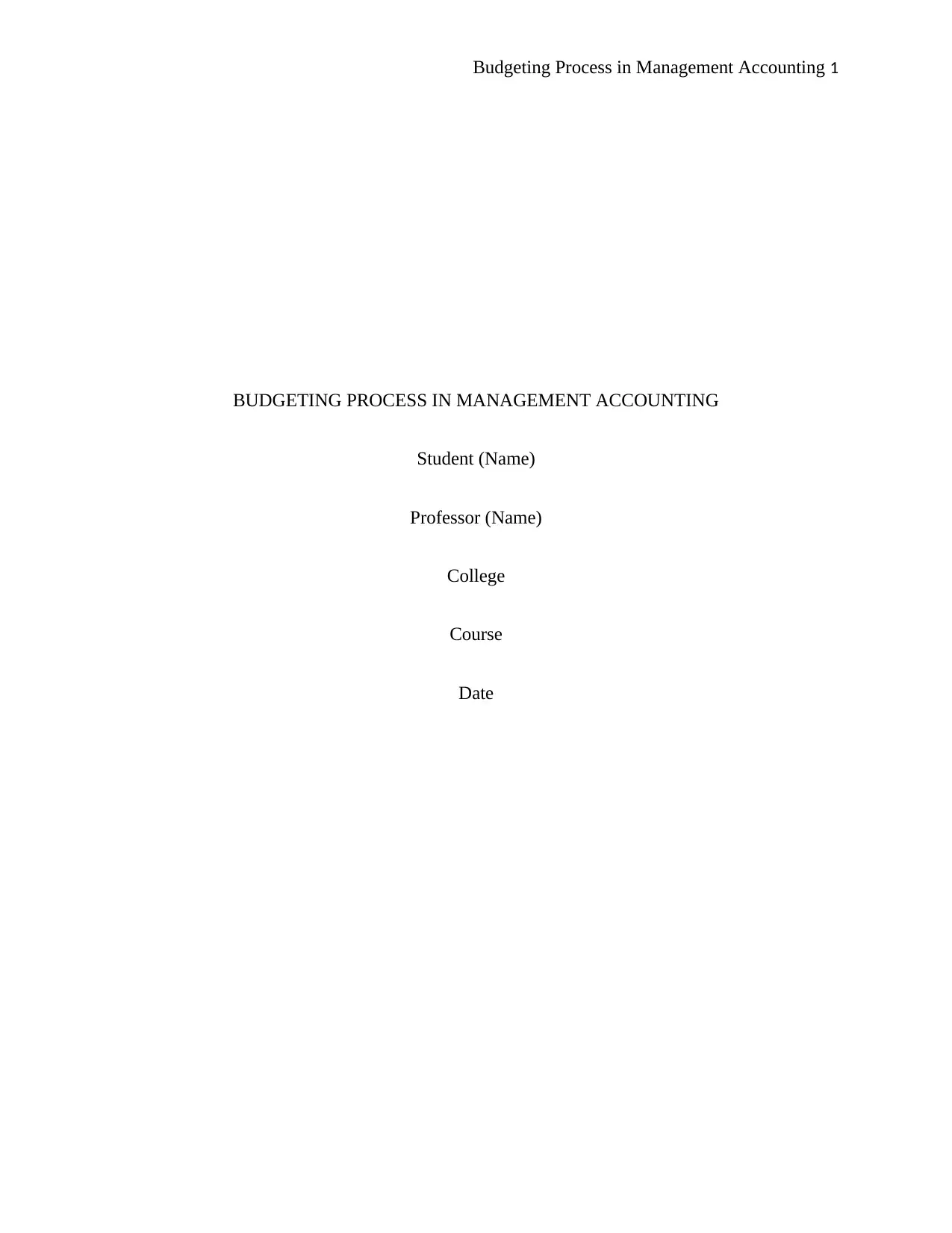
Budgeting Process in Management Accounting 1
BUDGETING PROCESS IN MANAGEMENT ACCOUNTING
Student (Name)
Professor (Name)
College
Course
Date
BUDGETING PROCESS IN MANAGEMENT ACCOUNTING
Student (Name)
Professor (Name)
College
Course
Date
Secure Best Marks with AI Grader
Need help grading? Try our AI Grader for instant feedback on your assignments.
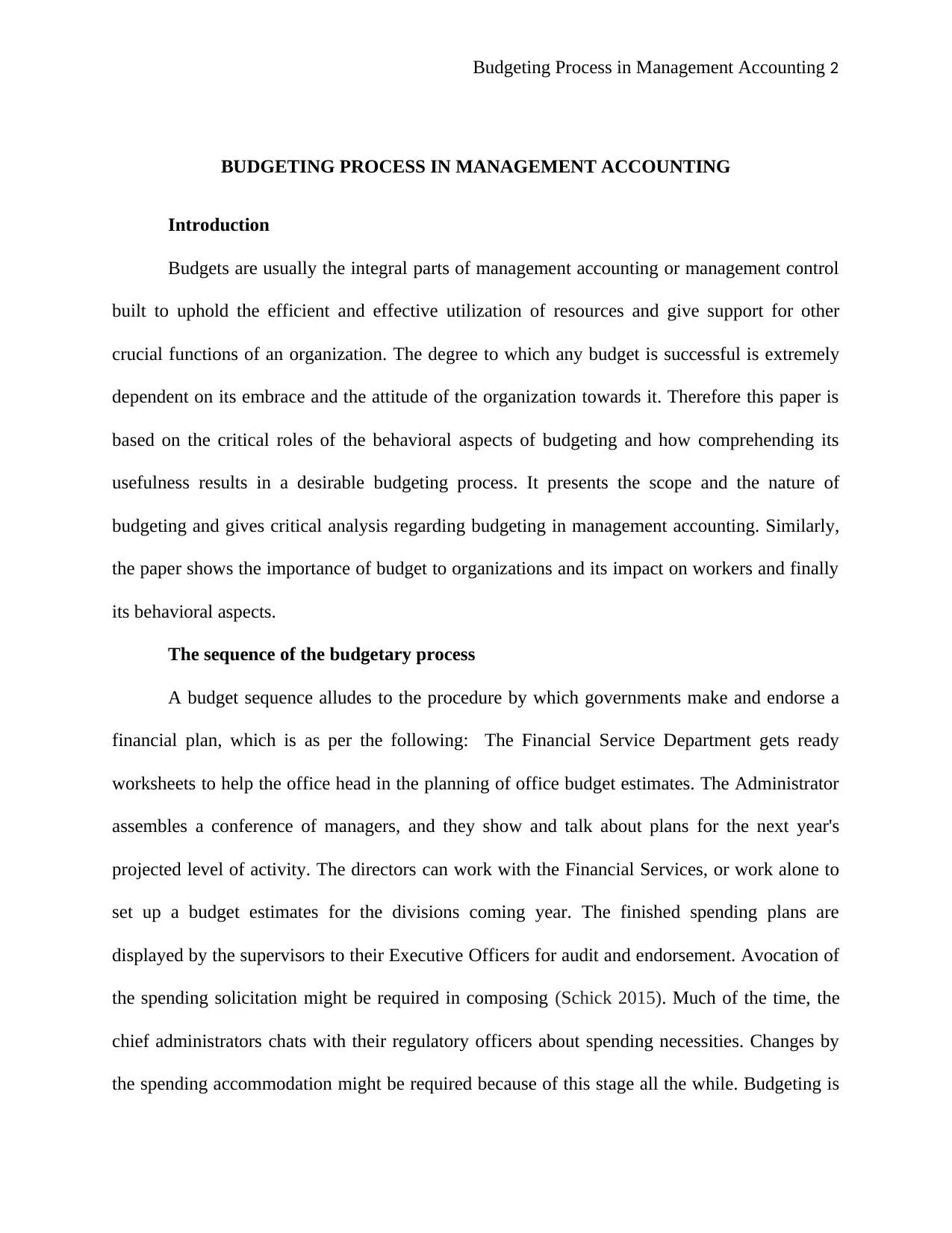
Budgeting Process in Management Accounting 2
BUDGETING PROCESS IN MANAGEMENT ACCOUNTING
Introduction
Budgets are usually the integral parts of management accounting or management control
built to uphold the efficient and effective utilization of resources and give support for other
crucial functions of an organization. The degree to which any budget is successful is extremely
dependent on its embrace and the attitude of the organization towards it. Therefore this paper is
based on the critical roles of the behavioral aspects of budgeting and how comprehending its
usefulness results in a desirable budgeting process. It presents the scope and the nature of
budgeting and gives critical analysis regarding budgeting in management accounting. Similarly,
the paper shows the importance of budget to organizations and its impact on workers and finally
its behavioral aspects.
The sequence of the budgetary process
A budget sequence alludes to the procedure by which governments make and endorse a
financial plan, which is as per the following: The Financial Service Department gets ready
worksheets to help the office head in the planning of office budget estimates. The Administrator
assembles a conference of managers, and they show and talk about plans for the next year's
projected level of activity. The directors can work with the Financial Services, or work alone to
set up a budget estimates for the divisions coming year. The finished spending plans are
displayed by the supervisors to their Executive Officers for audit and endorsement. Avocation of
the spending solicitation might be required in composing (Schick 2015). Much of the time, the
chief administrators chats with their regulatory officers about spending necessities. Changes by
the spending accommodation might be required because of this stage all the while. Budgeting is
BUDGETING PROCESS IN MANAGEMENT ACCOUNTING
Introduction
Budgets are usually the integral parts of management accounting or management control
built to uphold the efficient and effective utilization of resources and give support for other
crucial functions of an organization. The degree to which any budget is successful is extremely
dependent on its embrace and the attitude of the organization towards it. Therefore this paper is
based on the critical roles of the behavioral aspects of budgeting and how comprehending its
usefulness results in a desirable budgeting process. It presents the scope and the nature of
budgeting and gives critical analysis regarding budgeting in management accounting. Similarly,
the paper shows the importance of budget to organizations and its impact on workers and finally
its behavioral aspects.
The sequence of the budgetary process
A budget sequence alludes to the procedure by which governments make and endorse a
financial plan, which is as per the following: The Financial Service Department gets ready
worksheets to help the office head in the planning of office budget estimates. The Administrator
assembles a conference of managers, and they show and talk about plans for the next year's
projected level of activity. The directors can work with the Financial Services, or work alone to
set up a budget estimates for the divisions coming year. The finished spending plans are
displayed by the supervisors to their Executive Officers for audit and endorsement. Avocation of
the spending solicitation might be required in composing (Schick 2015). Much of the time, the
chief administrators chats with their regulatory officers about spending necessities. Changes by
the spending accommodation might be required because of this stage all the while. Budgeting is
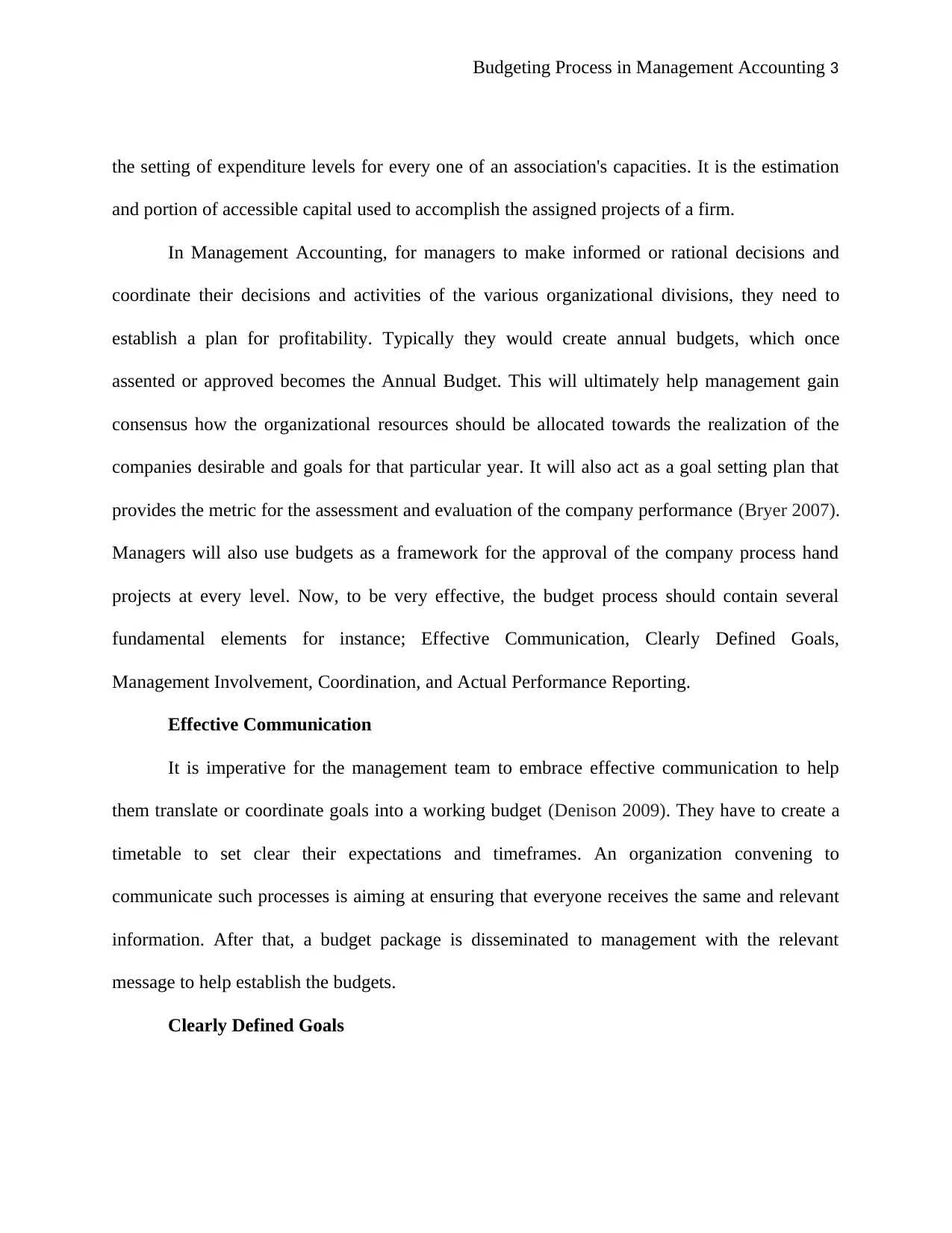
Budgeting Process in Management Accounting 3
the setting of expenditure levels for every one of an association's capacities. It is the estimation
and portion of accessible capital used to accomplish the assigned projects of a firm.
In Management Accounting, for managers to make informed or rational decisions and
coordinate their decisions and activities of the various organizational divisions, they need to
establish a plan for profitability. Typically they would create annual budgets, which once
assented or approved becomes the Annual Budget. This will ultimately help management gain
consensus how the organizational resources should be allocated towards the realization of the
companies desirable and goals for that particular year. It will also act as a goal setting plan that
provides the metric for the assessment and evaluation of the company performance (Bryer 2007).
Managers will also use budgets as a framework for the approval of the company process hand
projects at every level. Now, to be very effective, the budget process should contain several
fundamental elements for instance; Effective Communication, Clearly Defined Goals,
Management Involvement, Coordination, and Actual Performance Reporting.
Effective Communication
It is imperative for the management team to embrace effective communication to help
them translate or coordinate goals into a working budget (Denison 2009). They have to create a
timetable to set clear their expectations and timeframes. An organization convening to
communicate such processes is aiming at ensuring that everyone receives the same and relevant
information. After that, a budget package is disseminated to management with the relevant
message to help establish the budgets.
Clearly Defined Goals
the setting of expenditure levels for every one of an association's capacities. It is the estimation
and portion of accessible capital used to accomplish the assigned projects of a firm.
In Management Accounting, for managers to make informed or rational decisions and
coordinate their decisions and activities of the various organizational divisions, they need to
establish a plan for profitability. Typically they would create annual budgets, which once
assented or approved becomes the Annual Budget. This will ultimately help management gain
consensus how the organizational resources should be allocated towards the realization of the
companies desirable and goals for that particular year. It will also act as a goal setting plan that
provides the metric for the assessment and evaluation of the company performance (Bryer 2007).
Managers will also use budgets as a framework for the approval of the company process hand
projects at every level. Now, to be very effective, the budget process should contain several
fundamental elements for instance; Effective Communication, Clearly Defined Goals,
Management Involvement, Coordination, and Actual Performance Reporting.
Effective Communication
It is imperative for the management team to embrace effective communication to help
them translate or coordinate goals into a working budget (Denison 2009). They have to create a
timetable to set clear their expectations and timeframes. An organization convening to
communicate such processes is aiming at ensuring that everyone receives the same and relevant
information. After that, a budget package is disseminated to management with the relevant
message to help establish the budgets.
Clearly Defined Goals
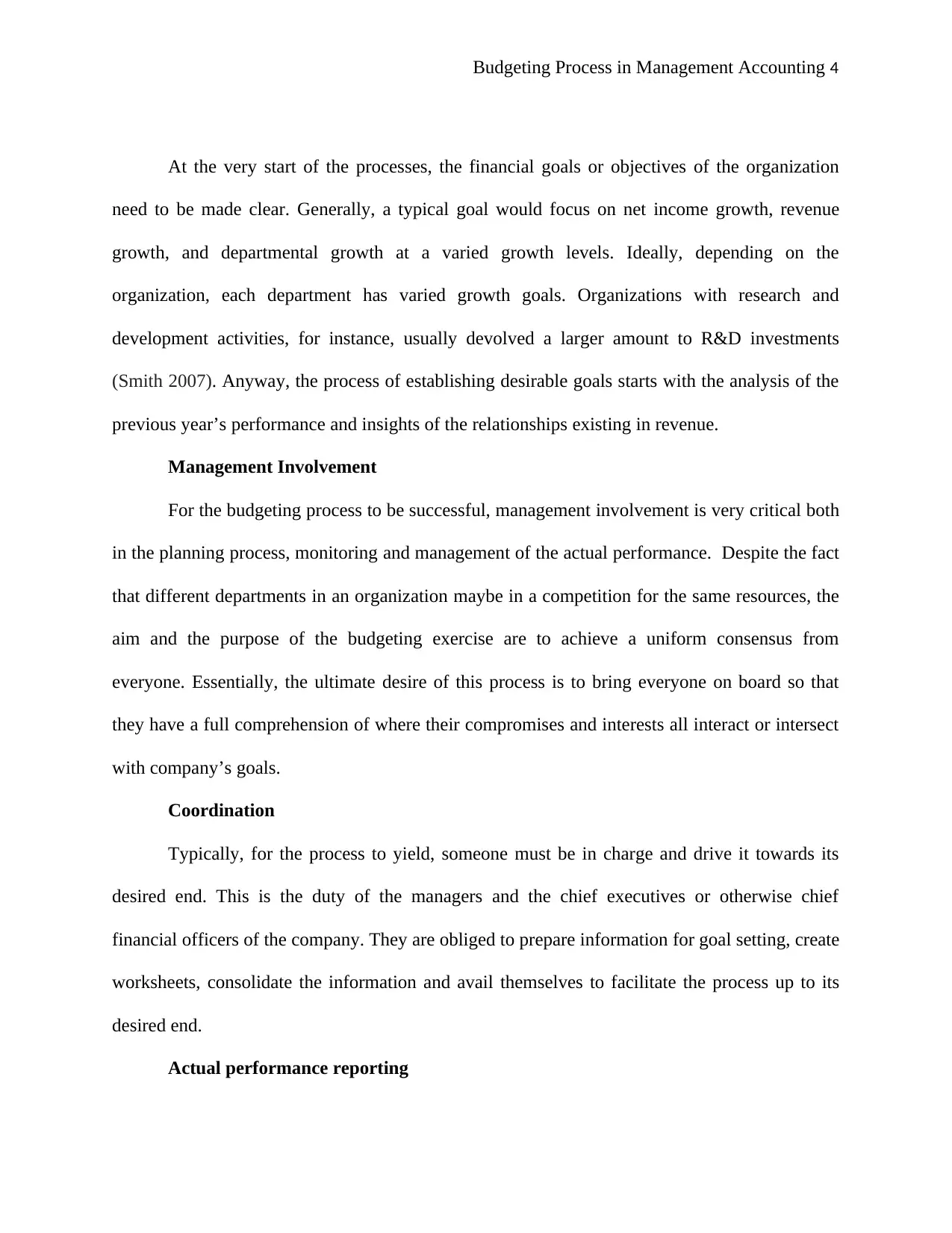
Budgeting Process in Management Accounting 4
At the very start of the processes, the financial goals or objectives of the organization
need to be made clear. Generally, a typical goal would focus on net income growth, revenue
growth, and departmental growth at a varied growth levels. Ideally, depending on the
organization, each department has varied growth goals. Organizations with research and
development activities, for instance, usually devolved a larger amount to R&D investments
(Smith 2007). Anyway, the process of establishing desirable goals starts with the analysis of the
previous year’s performance and insights of the relationships existing in revenue.
Management Involvement
For the budgeting process to be successful, management involvement is very critical both
in the planning process, monitoring and management of the actual performance. Despite the fact
that different departments in an organization maybe in a competition for the same resources, the
aim and the purpose of the budgeting exercise are to achieve a uniform consensus from
everyone. Essentially, the ultimate desire of this process is to bring everyone on board so that
they have a full comprehension of where their compromises and interests all interact or intersect
with company’s goals.
Coordination
Typically, for the process to yield, someone must be in charge and drive it towards its
desired end. This is the duty of the managers and the chief executives or otherwise chief
financial officers of the company. They are obliged to prepare information for goal setting, create
worksheets, consolidate the information and avail themselves to facilitate the process up to its
desired end.
Actual performance reporting
At the very start of the processes, the financial goals or objectives of the organization
need to be made clear. Generally, a typical goal would focus on net income growth, revenue
growth, and departmental growth at a varied growth levels. Ideally, depending on the
organization, each department has varied growth goals. Organizations with research and
development activities, for instance, usually devolved a larger amount to R&D investments
(Smith 2007). Anyway, the process of establishing desirable goals starts with the analysis of the
previous year’s performance and insights of the relationships existing in revenue.
Management Involvement
For the budgeting process to be successful, management involvement is very critical both
in the planning process, monitoring and management of the actual performance. Despite the fact
that different departments in an organization maybe in a competition for the same resources, the
aim and the purpose of the budgeting exercise are to achieve a uniform consensus from
everyone. Essentially, the ultimate desire of this process is to bring everyone on board so that
they have a full comprehension of where their compromises and interests all interact or intersect
with company’s goals.
Coordination
Typically, for the process to yield, someone must be in charge and drive it towards its
desired end. This is the duty of the managers and the chief executives or otherwise chief
financial officers of the company. They are obliged to prepare information for goal setting, create
worksheets, consolidate the information and avail themselves to facilitate the process up to its
desired end.
Actual performance reporting
Secure Best Marks with AI Grader
Need help grading? Try our AI Grader for instant feedback on your assignments.
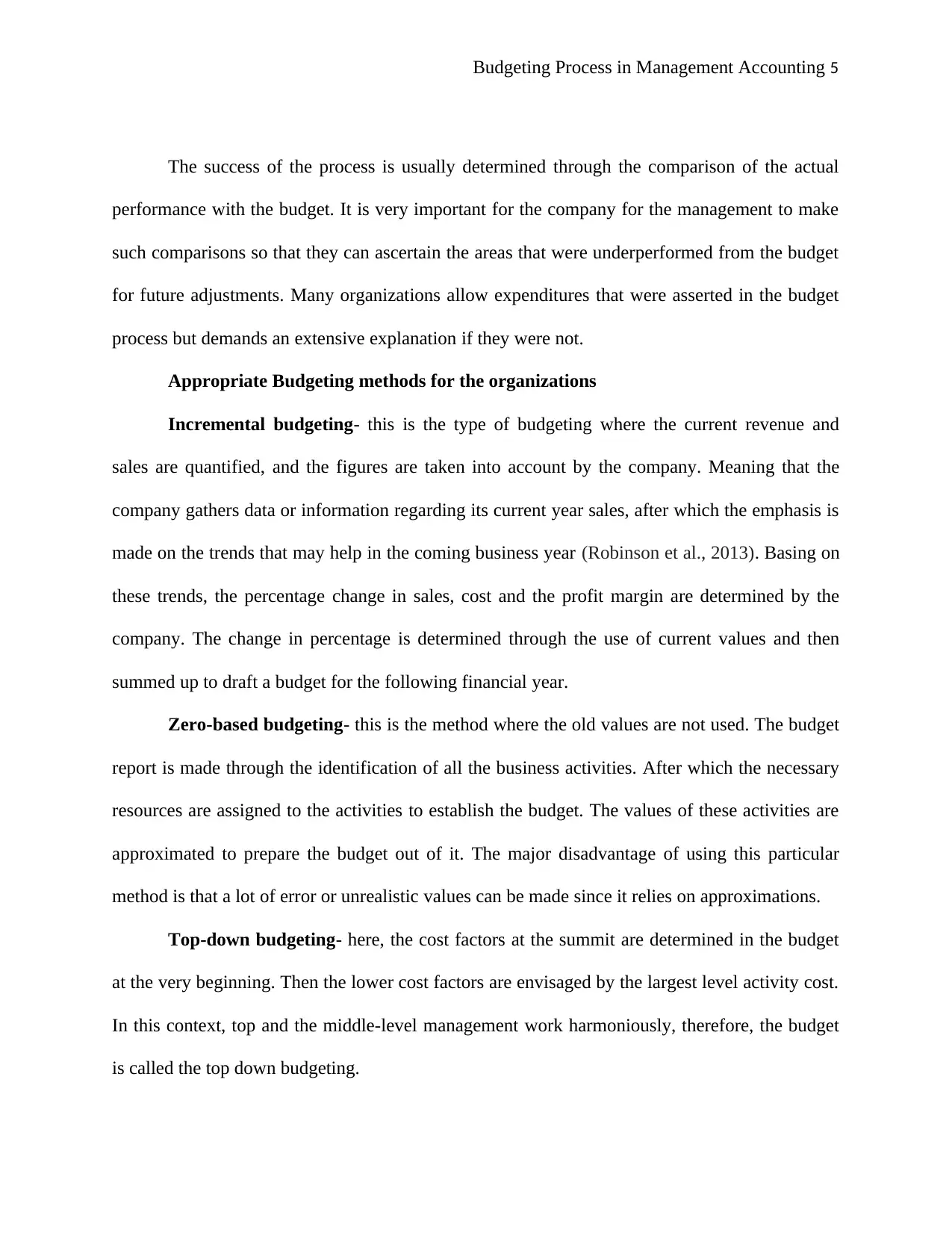
Budgeting Process in Management Accounting 5
The success of the process is usually determined through the comparison of the actual
performance with the budget. It is very important for the company for the management to make
such comparisons so that they can ascertain the areas that were underperformed from the budget
for future adjustments. Many organizations allow expenditures that were asserted in the budget
process but demands an extensive explanation if they were not.
Appropriate Budgeting methods for the organizations
Incremental budgeting- this is the type of budgeting where the current revenue and
sales are quantified, and the figures are taken into account by the company. Meaning that the
company gathers data or information regarding its current year sales, after which the emphasis is
made on the trends that may help in the coming business year (Robinson et al., 2013). Basing on
these trends, the percentage change in sales, cost and the profit margin are determined by the
company. The change in percentage is determined through the use of current values and then
summed up to draft a budget for the following financial year.
Zero-based budgeting- this is the method where the old values are not used. The budget
report is made through the identification of all the business activities. After which the necessary
resources are assigned to the activities to establish the budget. The values of these activities are
approximated to prepare the budget out of it. The major disadvantage of using this particular
method is that a lot of error or unrealistic values can be made since it relies on approximations.
Top-down budgeting- here, the cost factors at the summit are determined in the budget
at the very beginning. Then the lower cost factors are envisaged by the largest level activity cost.
In this context, top and the middle-level management work harmoniously, therefore, the budget
is called the top down budgeting.
The success of the process is usually determined through the comparison of the actual
performance with the budget. It is very important for the company for the management to make
such comparisons so that they can ascertain the areas that were underperformed from the budget
for future adjustments. Many organizations allow expenditures that were asserted in the budget
process but demands an extensive explanation if they were not.
Appropriate Budgeting methods for the organizations
Incremental budgeting- this is the type of budgeting where the current revenue and
sales are quantified, and the figures are taken into account by the company. Meaning that the
company gathers data or information regarding its current year sales, after which the emphasis is
made on the trends that may help in the coming business year (Robinson et al., 2013). Basing on
these trends, the percentage change in sales, cost and the profit margin are determined by the
company. The change in percentage is determined through the use of current values and then
summed up to draft a budget for the following financial year.
Zero-based budgeting- this is the method where the old values are not used. The budget
report is made through the identification of all the business activities. After which the necessary
resources are assigned to the activities to establish the budget. The values of these activities are
approximated to prepare the budget out of it. The major disadvantage of using this particular
method is that a lot of error or unrealistic values can be made since it relies on approximations.
Top-down budgeting- here, the cost factors at the summit are determined in the budget
at the very beginning. Then the lower cost factors are envisaged by the largest level activity cost.
In this context, top and the middle-level management work harmoniously, therefore, the budget
is called the top down budgeting.
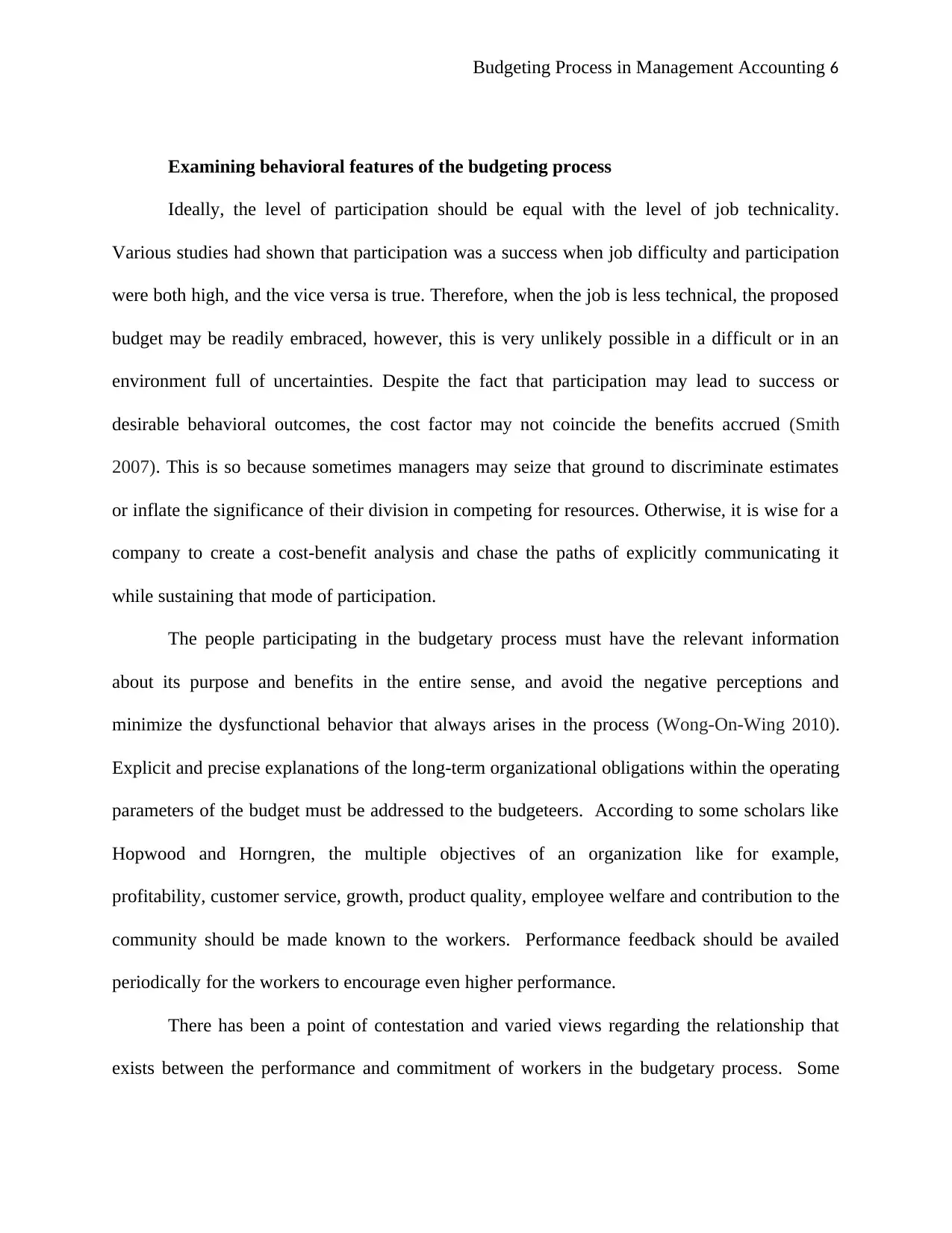
Budgeting Process in Management Accounting 6
Examining behavioral features of the budgeting process
Ideally, the level of participation should be equal with the level of job technicality.
Various studies had shown that participation was a success when job difficulty and participation
were both high, and the vice versa is true. Therefore, when the job is less technical, the proposed
budget may be readily embraced, however, this is very unlikely possible in a difficult or in an
environment full of uncertainties. Despite the fact that participation may lead to success or
desirable behavioral outcomes, the cost factor may not coincide the benefits accrued (Smith
2007). This is so because sometimes managers may seize that ground to discriminate estimates
or inflate the significance of their division in competing for resources. Otherwise, it is wise for a
company to create a cost-benefit analysis and chase the paths of explicitly communicating it
while sustaining that mode of participation.
The people participating in the budgetary process must have the relevant information
about its purpose and benefits in the entire sense, and avoid the negative perceptions and
minimize the dysfunctional behavior that always arises in the process (Wong-On-Wing 2010).
Explicit and precise explanations of the long-term organizational obligations within the operating
parameters of the budget must be addressed to the budgeteers. According to some scholars like
Hopwood and Horngren, the multiple objectives of an organization like for example,
profitability, customer service, growth, product quality, employee welfare and contribution to the
community should be made known to the workers. Performance feedback should be availed
periodically for the workers to encourage even higher performance.
There has been a point of contestation and varied views regarding the relationship that
exists between the performance and commitment of workers in the budgetary process. Some
Examining behavioral features of the budgeting process
Ideally, the level of participation should be equal with the level of job technicality.
Various studies had shown that participation was a success when job difficulty and participation
were both high, and the vice versa is true. Therefore, when the job is less technical, the proposed
budget may be readily embraced, however, this is very unlikely possible in a difficult or in an
environment full of uncertainties. Despite the fact that participation may lead to success or
desirable behavioral outcomes, the cost factor may not coincide the benefits accrued (Smith
2007). This is so because sometimes managers may seize that ground to discriminate estimates
or inflate the significance of their division in competing for resources. Otherwise, it is wise for a
company to create a cost-benefit analysis and chase the paths of explicitly communicating it
while sustaining that mode of participation.
The people participating in the budgetary process must have the relevant information
about its purpose and benefits in the entire sense, and avoid the negative perceptions and
minimize the dysfunctional behavior that always arises in the process (Wong-On-Wing 2010).
Explicit and precise explanations of the long-term organizational obligations within the operating
parameters of the budget must be addressed to the budgeteers. According to some scholars like
Hopwood and Horngren, the multiple objectives of an organization like for example,
profitability, customer service, growth, product quality, employee welfare and contribution to the
community should be made known to the workers. Performance feedback should be availed
periodically for the workers to encourage even higher performance.
There has been a point of contestation and varied views regarding the relationship that
exists between the performance and commitment of workers in the budgetary process. Some
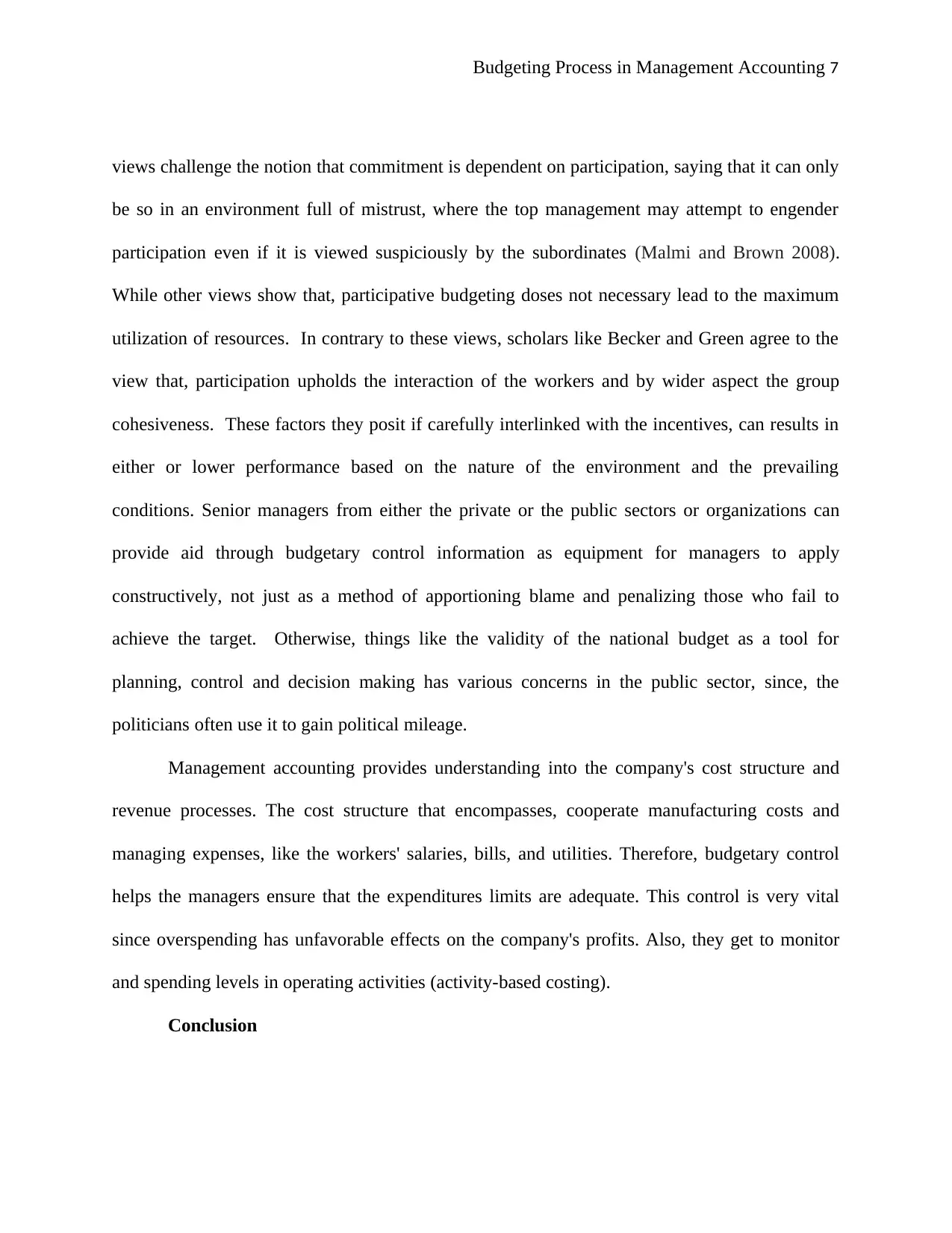
Budgeting Process in Management Accounting 7
views challenge the notion that commitment is dependent on participation, saying that it can only
be so in an environment full of mistrust, where the top management may attempt to engender
participation even if it is viewed suspiciously by the subordinates (Malmi and Brown 2008).
While other views show that, participative budgeting doses not necessary lead to the maximum
utilization of resources. In contrary to these views, scholars like Becker and Green agree to the
view that, participation upholds the interaction of the workers and by wider aspect the group
cohesiveness. These factors they posit if carefully interlinked with the incentives, can results in
either or lower performance based on the nature of the environment and the prevailing
conditions. Senior managers from either the private or the public sectors or organizations can
provide aid through budgetary control information as equipment for managers to apply
constructively, not just as a method of apportioning blame and penalizing those who fail to
achieve the target. Otherwise, things like the validity of the national budget as a tool for
planning, control and decision making has various concerns in the public sector, since, the
politicians often use it to gain political mileage.
Management accounting provides understanding into the company's cost structure and
revenue processes. The cost structure that encompasses, cooperate manufacturing costs and
managing expenses, like the workers' salaries, bills, and utilities. Therefore, budgetary control
helps the managers ensure that the expenditures limits are adequate. This control is very vital
since overspending has unfavorable effects on the company's profits. Also, they get to monitor
and spending levels in operating activities (activity-based costing).
Conclusion
views challenge the notion that commitment is dependent on participation, saying that it can only
be so in an environment full of mistrust, where the top management may attempt to engender
participation even if it is viewed suspiciously by the subordinates (Malmi and Brown 2008).
While other views show that, participative budgeting doses not necessary lead to the maximum
utilization of resources. In contrary to these views, scholars like Becker and Green agree to the
view that, participation upholds the interaction of the workers and by wider aspect the group
cohesiveness. These factors they posit if carefully interlinked with the incentives, can results in
either or lower performance based on the nature of the environment and the prevailing
conditions. Senior managers from either the private or the public sectors or organizations can
provide aid through budgetary control information as equipment for managers to apply
constructively, not just as a method of apportioning blame and penalizing those who fail to
achieve the target. Otherwise, things like the validity of the national budget as a tool for
planning, control and decision making has various concerns in the public sector, since, the
politicians often use it to gain political mileage.
Management accounting provides understanding into the company's cost structure and
revenue processes. The cost structure that encompasses, cooperate manufacturing costs and
managing expenses, like the workers' salaries, bills, and utilities. Therefore, budgetary control
helps the managers ensure that the expenditures limits are adequate. This control is very vital
since overspending has unfavorable effects on the company's profits. Also, they get to monitor
and spending levels in operating activities (activity-based costing).
Conclusion
Paraphrase This Document
Need a fresh take? Get an instant paraphrase of this document with our AI Paraphraser
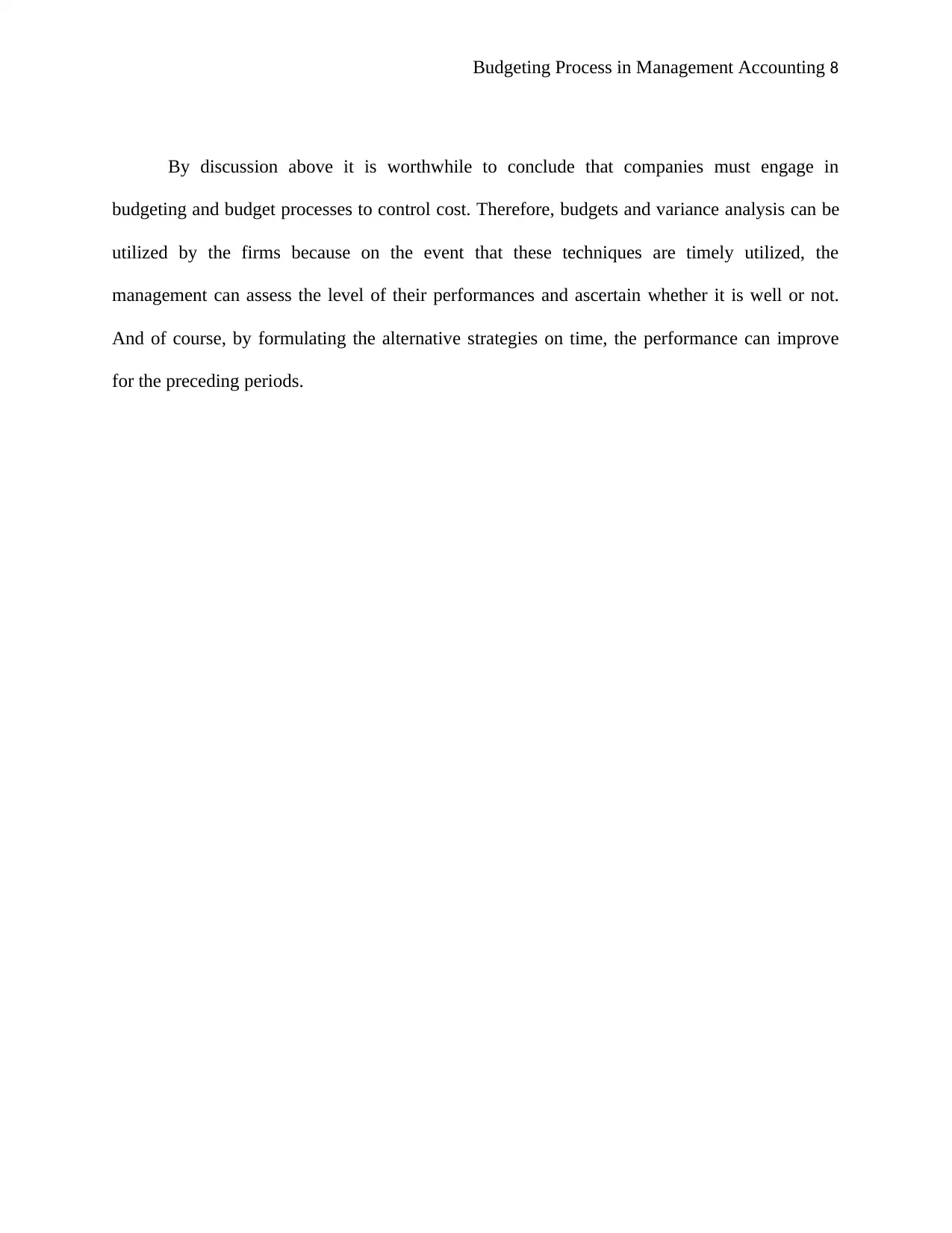
Budgeting Process in Management Accounting 8
By discussion above it is worthwhile to conclude that companies must engage in
budgeting and budget processes to control cost. Therefore, budgets and variance analysis can be
utilized by the firms because on the event that these techniques are timely utilized, the
management can assess the level of their performances and ascertain whether it is well or not.
And of course, by formulating the alternative strategies on time, the performance can improve
for the preceding periods.
By discussion above it is worthwhile to conclude that companies must engage in
budgeting and budget processes to control cost. Therefore, budgets and variance analysis can be
utilized by the firms because on the event that these techniques are timely utilized, the
management can assess the level of their performances and ascertain whether it is well or not.
And of course, by formulating the alternative strategies on time, the performance can improve
for the preceding periods.
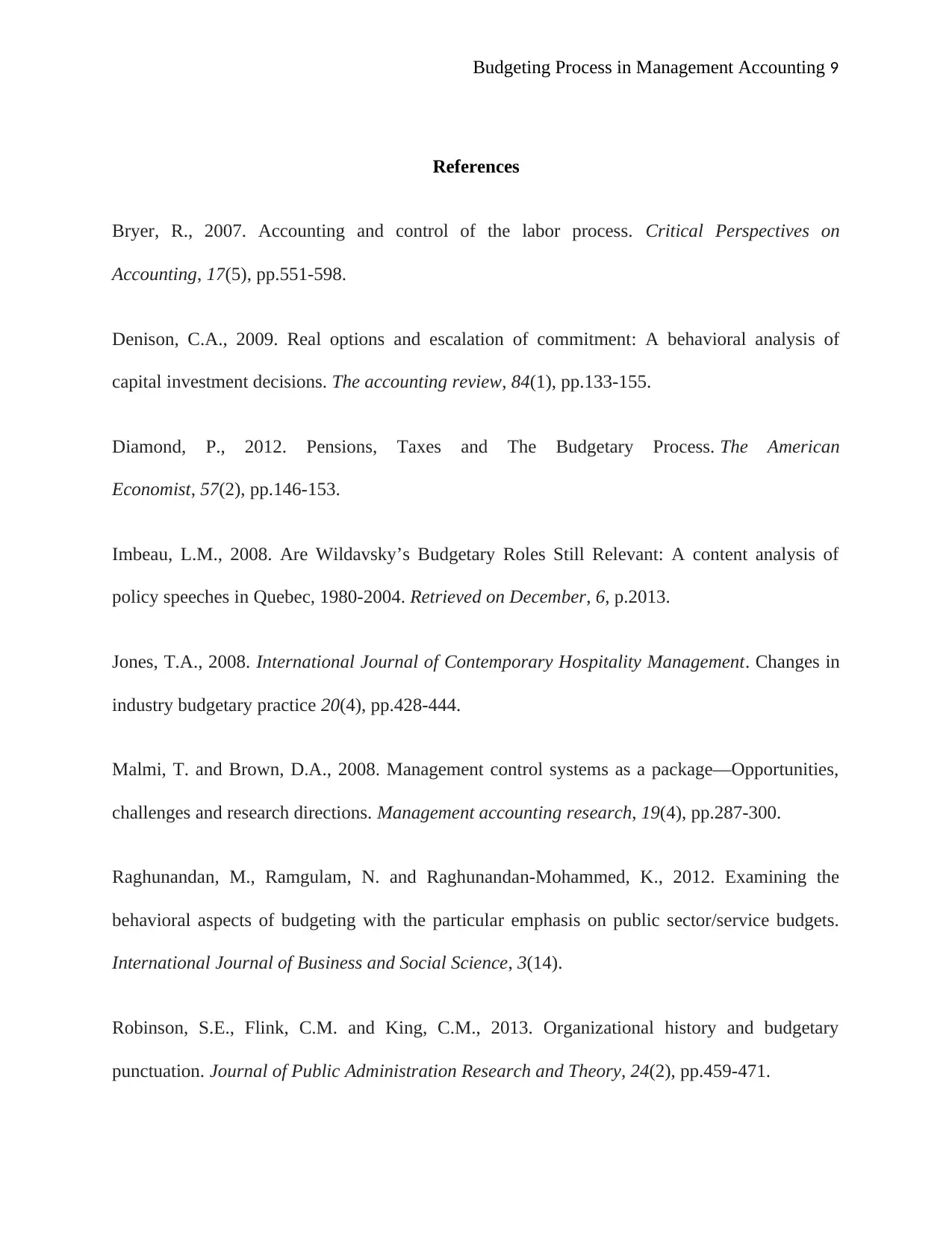
Budgeting Process in Management Accounting 9
References
Bryer, R., 2007. Accounting and control of the labor process. Critical Perspectives on
Accounting, 17(5), pp.551-598.
Denison, C.A., 2009. Real options and escalation of commitment: A behavioral analysis of
capital investment decisions. The accounting review, 84(1), pp.133-155.
Diamond, P., 2012. Pensions, Taxes and The Budgetary Process. The American
Economist, 57(2), pp.146-153.
Imbeau, L.M., 2008. Are Wildavsky’s Budgetary Roles Still Relevant: A content analysis of
policy speeches in Quebec, 1980-2004. Retrieved on December, 6, p.2013.
Jones, T.A., 2008. International Journal of Contemporary Hospitality Management. Changes in
industry budgetary practice 20(4), pp.428-444.
Malmi, T. and Brown, D.A., 2008. Management control systems as a package—Opportunities,
challenges and research directions. Management accounting research, 19(4), pp.287-300.
Raghunandan, M., Ramgulam, N. and Raghunandan-Mohammed, K., 2012. Examining the
behavioral aspects of budgeting with the particular emphasis on public sector/service budgets.
International Journal of Business and Social Science, 3(14).
Robinson, S.E., Flink, C.M. and King, C.M., 2013. Organizational history and budgetary
punctuation. Journal of Public Administration Research and Theory, 24(2), pp.459-471.
References
Bryer, R., 2007. Accounting and control of the labor process. Critical Perspectives on
Accounting, 17(5), pp.551-598.
Denison, C.A., 2009. Real options and escalation of commitment: A behavioral analysis of
capital investment decisions. The accounting review, 84(1), pp.133-155.
Diamond, P., 2012. Pensions, Taxes and The Budgetary Process. The American
Economist, 57(2), pp.146-153.
Imbeau, L.M., 2008. Are Wildavsky’s Budgetary Roles Still Relevant: A content analysis of
policy speeches in Quebec, 1980-2004. Retrieved on December, 6, p.2013.
Jones, T.A., 2008. International Journal of Contemporary Hospitality Management. Changes in
industry budgetary practice 20(4), pp.428-444.
Malmi, T. and Brown, D.A., 2008. Management control systems as a package—Opportunities,
challenges and research directions. Management accounting research, 19(4), pp.287-300.
Raghunandan, M., Ramgulam, N. and Raghunandan-Mohammed, K., 2012. Examining the
behavioral aspects of budgeting with the particular emphasis on public sector/service budgets.
International Journal of Business and Social Science, 3(14).
Robinson, S.E., Flink, C.M. and King, C.M., 2013. Organizational history and budgetary
punctuation. Journal of Public Administration Research and Theory, 24(2), pp.459-471.
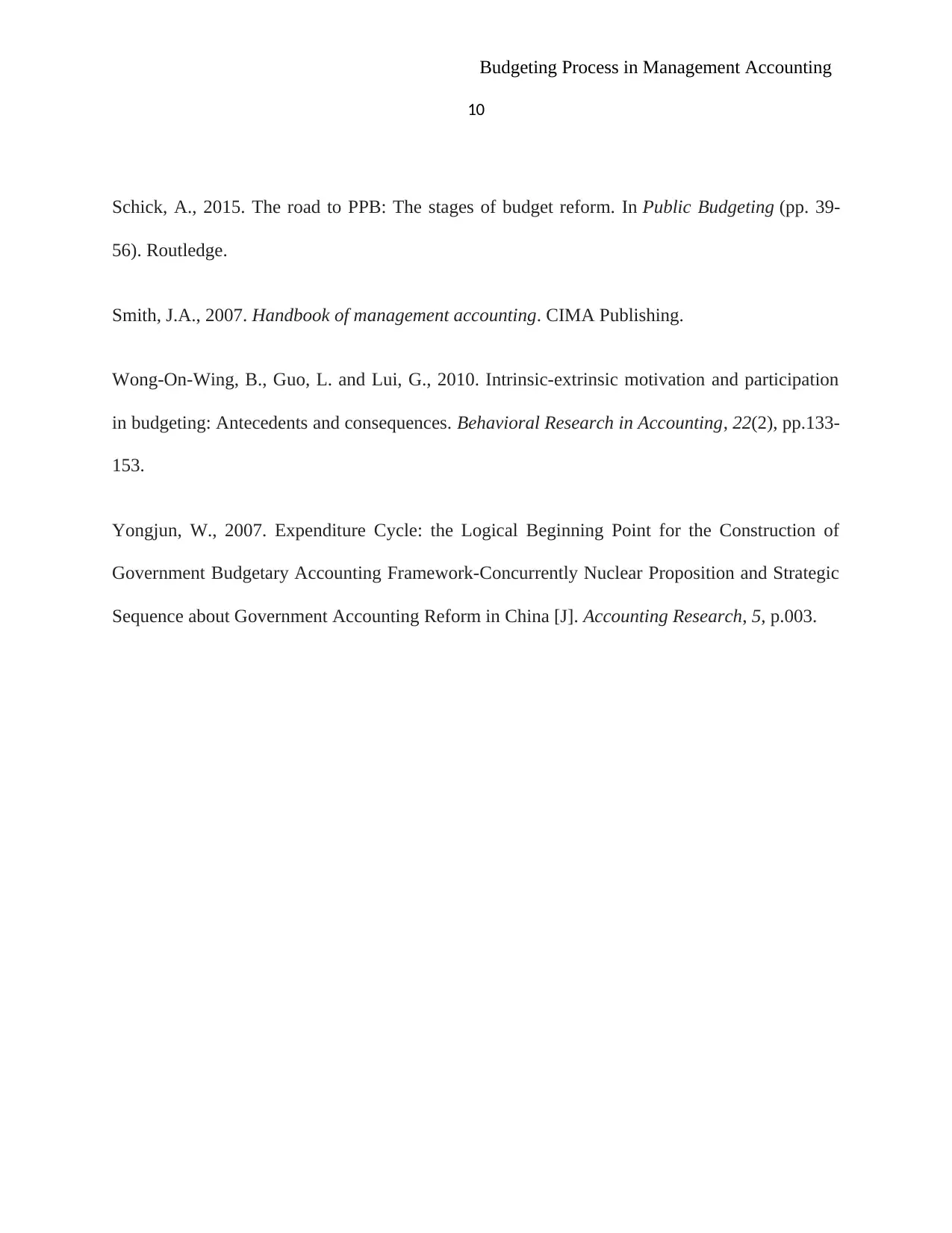
Budgeting Process in Management Accounting
10
Schick, A., 2015. The road to PPB: The stages of budget reform. In Public Budgeting (pp. 39-
56). Routledge.
Smith, J.A., 2007. Handbook of management accounting. CIMA Publishing.
Wong-On-Wing, B., Guo, L. and Lui, G., 2010. Intrinsic-extrinsic motivation and participation
in budgeting: Antecedents and consequences. Behavioral Research in Accounting, 22(2), pp.133-
153.
Yongjun, W., 2007. Expenditure Cycle: the Logical Beginning Point for the Construction of
Government Budgetary Accounting Framework-Concurrently Nuclear Proposition and Strategic
Sequence about Government Accounting Reform in China [J]. Accounting Research, 5, p.003.
10
Schick, A., 2015. The road to PPB: The stages of budget reform. In Public Budgeting (pp. 39-
56). Routledge.
Smith, J.A., 2007. Handbook of management accounting. CIMA Publishing.
Wong-On-Wing, B., Guo, L. and Lui, G., 2010. Intrinsic-extrinsic motivation and participation
in budgeting: Antecedents and consequences. Behavioral Research in Accounting, 22(2), pp.133-
153.
Yongjun, W., 2007. Expenditure Cycle: the Logical Beginning Point for the Construction of
Government Budgetary Accounting Framework-Concurrently Nuclear Proposition and Strategic
Sequence about Government Accounting Reform in China [J]. Accounting Research, 5, p.003.
1 out of 10
Related Documents
Your All-in-One AI-Powered Toolkit for Academic Success.
+13062052269
info@desklib.com
Available 24*7 on WhatsApp / Email
![[object Object]](/_next/static/media/star-bottom.7253800d.svg)
Unlock your academic potential
© 2024 | Zucol Services PVT LTD | All rights reserved.





